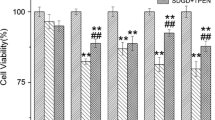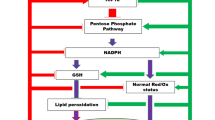Abstract
5′adenosine monophosphate-dependent protein kinase (AMPK) is a member of metabolite-sensing kinase family which plays an important role in intracellular energy metabolism, particularly in the hypoxic neurons process. However, the effect of AMPK activation on hypoxic neurons remains controversial. In the present study, we report that the effect of AMPK activation induced by pretreatment with 5-aminoimidazole-4-carboxamide-1-b-4-ribofuranoside (AICAR) in neurons using the hypoxic model in vitro. The level of AMPK activation, the neuronal viability, and the levels of two important cytoskeleton proteins were analyzed during the oxygen deprivation. The AMPK activation was increased with the elevation of the AICAR concentration in hypoxic neurons. Moreover, the AMPK activation induced by AICAR protected neurons against death from hypoxic deprivation and that strongly depended on the extent of the AMPK activation. The AMPK activation at specific range protects hypoxic neurons, but the protective effect of AMPK activation disappeared when the AMPK was over-activated by AICAR. The result from an AMPK inhibitor, Compound C, in hypoxic neurons further proves the neuroprotective effect of AICAR.






Similar content being viewed by others
References
Ramamurthy S, Ronnett GV (2006) Developing a head for energy sensing: AMP-activated protein kinase as a multifunctional metabolic sensor in the brain. J Physiol 574:85–93
Kahn BB, Alquier T, Carling D et al (2005) AMP-activated protein kinase: ancient energy gauge provides clues to modern understanding of metabolism. Cell Metab 1:15–25
Li J, Zeng Z, Viollet B et al (2007) Neuroprotective effects of adenosine monophosphate-activated protein kinase inhibition and gene deletion in stroke. Stroke. 38:2992–2999
Hawley SA, Davison M, Woods A et al (1996) Characterization of the AMP-activated protein kinase kinase from rat liver and identification of threonine 172 as the major site at which it phosphorylates AMP-activated protein kinase. J. Biol. Chem. 271:27879–27887
Russell RR, Li J, Coven DL et al (2004) AMP-activated protein kinase mediates ischemic glucose uptake and prevents postischemic cardiac dysfunction, apoptosis, and injury. J Clin Invest 114:495–503
Shaw RJ, Kosmatka M, Bardeesy N et al (2004) The tumor suppressor LKB1 kinase directly activates AMP-activated kinase and regulates apoptosis in response to energy stress. Proc Natl Acad Sci USA 101:3329–3335
Culmsee C, Monnig J, Kemp BE et al (2001) AMP-activated protein kinase is highly expressed in neurons in the developing rat brain and promotes neuronal survival following glucose deprivation. J Mol Neurosci 17:45–58
Park M, Song KS, Kim HK et al (2009) 2-Deoxy-d-glucose protects neural progenitor cells against oxidative stress through the activation of AMP-activated protein kinase. Neurosci Lett 449:201–206
Ronnett GV, Ramamurthy S, Kleman AM et al (2009) AMPK in the brain: its roles in energy balance and neuroprotection. J Neurochem 109(Suppl 1):17–23
Sullivan JE, Brocklehurst KJ, Marley AE et al (1994) Inhibition of lipolysis and lipogenesis in isolated rat adipocytes with AICAR, a cell-permeable activator of AMP-activated protein kinase. FEBS Lett 353:33–36
Corton JM, Gillespie JG, Hawley SA et al (1995) 5-aminoimidazole-4-carboxamide ribonucleoside. A specific method for activating AMP-activated protein kinase in intact cells? Eur J Biochem 229:558–565
Choi K, Mollapour E, Choi JH et al (2008) Cellular energetic status supervises the synthesis of bis-diphosphoinositol tetrakisphosphate independently of AMP-activated protein kinase. Mol Pharmacol 74:527–536
Brewer GJ (1995) Serum-free B27/neurobasal medium supports differentiated growth of neurons from the striatum, substantia nigra, septum, cerebral cortex, cerebellum, and dentate gyrus. J Neurosci Res 42:674–683
Leff T (2003) AMP-activated protein kinase regulates gene expression by direct phosphorylation of nuclear proteins. Biochem Soc Trans 31:224–227
Kim EK, Miller I, Aja S et al (2004) C75, a fatty acid synthase inhibitor, reduces food intake via hypothalamic AMP-activated protein kinase. J Biol Chem 279:19970–19976
King TD, Song L, Jope RS (2006) AMP-activated protein kinase (AMPK) activating agents cause dephosphorylation of Akt and glycogen synthase kinase-3. Biochem Pharmacol 71:1637–1647
McCullough LD, Zeng Z, Li H et al (2005) Pharmacological inhibition of AMP-activated protein kinase provides neuroprotection in stroke. J Biol Chem 280:20493–20502
Qi Z, Bu X, Huang P et al (2007) Increased membrane/nuclear translocation and phosphorylation of p90 KD ribosomal S6 kinase in the brain of hypoxic preconditioned mice. Neurochem Res 32:1450–1459
Youssef FF, Addae JI, Stone TW (2006) NMDA-induced preconditioning attenuates synaptic plasticity in the rat hippocampus. Brain Res 1073–1074:183–189
Zhang Y, Park TS, Gidday JM (2007) Hypoxic preconditioning protects human brain endothelium from ischemic apoptosis by Akt-dependent survivin activation. Am J Physiol Heart Circ Physiol 292:H2573–H2581
Acknowledgments
This work was financially supported by the National S & T Major Project of China (No. 2009ZX09103-105), SRFDP (No. 20090061120093), and Research foundation of Jilin University (No. 421031313427).
Author information
Authors and Affiliations
Corresponding authors
Additional information
The authors Xiaolu Zhang and Rongkun Gao contributed equally as first author to this work.
Rights and permissions
About this article
Cite this article
Zhang, X., Gao, R., Li, J. et al. A Pharmacological Activator of AMP-Activated Protein Kinase Protects Hypoxic Neurons in a Concentration-Dependent Manner. Neurochem Res 35, 1281–1289 (2010). https://doi.org/10.1007/s11064-010-0186-3
Accepted:
Published:
Issue Date:
DOI: https://doi.org/10.1007/s11064-010-0186-3




